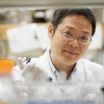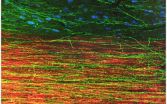(Press-News.org) WEST LAFAYETTE, Ind. - A Purdue University study shows that Notch signaling, a key biological pathway tied to development and cell communication, also plays an important role in the onset of obesity and Type 2 diabetes, a discovery that offers new targets for treatment.
A research team led by Shihuan Kuang, associate professor of animal sciences, found that blocking Notch signaling in the fat tissue of mice caused white fat cells to transform into a "leaner" type of fat known as beige fat. The finding suggests that suppressing Notch signaling in fat cells could reduce the risk of obesity and related health problems, Kuang said.
"This finding opens up a whole new avenue to understanding how fat is controlled at the molecular level," he said. "Now that we know Notch signaling and obesity are linked in this way, we can work on developing new therapeutics."
The human body houses three kinds of fat: white, brown and beige. White fat tissue stores fatty acids and is the main culprit in weight gain. Brown fat, which helps keep hibernating animals and infants warm, burns fatty acids to produce heat. Humans lose most of their brown fat as they mature, but they retain a similar kind of fat - beige fat, which also generates heat by breaking down fatty acids.
Buried in white fat tissue, beige fat cells are unique in that they can become white fat cells depending on the body's metabolic needs. White fat cells can also transform into beige fat cells in a process known as browning, which raises the body's metabolism and cuts down on obesity.
Kuang and his team found that the Notch signaling pathway inhibits browning of white fat by regulating expression of genes that are related to beige fat tissue.
"The Notch pathway functions like a commander, telling the cell to make white fat," he said.
Suppressing key genes in the Notch pathway in the fat tissue of mice caused them to burn more energy than wild-type mice, reducing their fat mass and raising their metabolism. The transgenic mice stayed leaner than their wild-type littermates even though their daily energy intake was similar, Kuang said. They also had a higher sensitivity to insulin, a lower blood glucose level and were more resistant to weight gain when fed a high-fat diet.
Pengpeng Bi, a doctoral candidate in animal sciences and first author of the study, said that the transgenic mice's body fat appeared browner upon dissection than the fat in wild-type mice, suggesting that blocking the Notch pathway had increased the number of their beige fat cells.
"Otherwise they looked normal," he said. "We did not notice anything exceptional about them until we looked at the fat."
Kuang and his team found that giving obese mice dibenzazepine, a drug that suppresses the Notch signaling pathway, reduced their obesity and improved their glucose balance.
Because the Notch signaling pathway is very similar in mice and humans, Kuang sees the results as having important implications for treating obesity and Type 2 diabetes in humans.
Type 2 diabetes, formerly known as "adult-onset diabetes," is a chronic ailment that particularly affects people who are overweight, lead sedentary lifestyles or have poor nutrition.
"This gives us new targets in the fight against obesity," Kuang said. "Inhibiting genes in the Notch pathway can convert white fat into beige and could reverse some of the effects of diabetes by renewing the body's sensitivity to insulin."
INFORMATION:
The study was published in Nature Medicine and is available at http://www.nature.com/nm/journal/vaop/ncurrent/full/nm.3615.html.
The research was funded in part by the National Institutes of Health.
Cell signaling pathway linked to obesity, type 2 diabetes
2014-08-07
ELSE PRESS RELEASES FROM THIS DATE:
Gut microbes browse along a gene buffet
2014-08-07
DURHAM, N.C. -- In the moist, dark microbial rainforest of the intestine, hundreds of species of microorganisms interact with each other and with the cells of the host animal to get the resources they need to survive and thrive.
Though there's a lot of competition in this vibrant ecosystem, collaboration is valued too. A new study on the crosstalk between microbes and cells lining the gut of mice shows just how cooperative this environment can be.
One of the main ways that hosts manage their interactions with microbes is by carefully controlling the genes that their ...
NASA sees Hurricane Julio organize and emit a gamma-ray flash
2014-08-07
NASA's Fermi and Aqua satellites captured two different views of bursts of strength show by Hurricane Julio as it intensified. NASA's Fermi satellite saw a gamma-ray flash from Julio, while NASA's Aqua satellite saw Julio become more structurally organized as a hurricane.
This type of outburst is known as a terrestrial gamma-ray flash (TGF). Produced by the powerful electric fields in thunderstorms, TGFs last only a few thousandths of a second but emit gamma rays that make up the highest-energy naturally-occurring light on Earth. Scientists estimate that, on average, ...
Wild sheep show benefits of putting up with parasites
2014-08-07
In the first evidence that natural selection favors an individual's infection tolerance, researchers from Princeton University and the University of Edinburgh have found that an animal's ability to endure an internal parasite strongly influences its reproductive success. Reported in the journal PLoS Biology, the finding could provide the groundwork for boosting the resilience of humans and livestock to infection.
The researchers used 25 years of data on a population of wild sheep living on an island in northwest Scotland to assess the evolutionary importance of infection ...
NASA sees Genevieve cross international date line as a Super-Typhoon
2014-08-07
Tropical Storm Genevieve had ups and downs in the Eastern Pacific and Central Pacific over the last week but once the storm crossed the International Dateline in the Pacific, it rapidly intensified into a Super Typhoon. NASA-NOAA's Suomi NPP satellite captured of the storm.
When Suomi NPP flew over Genevieve on August 7 at 01:48 UTC the Visible Infrared Imaging Radiometer Suite (VIIRS) instrument aboard captured an infrared image of the storm. VIIRS collects visible and infrared imagery and global observations of land, atmosphere, cryosphere and oceans. VIIRS flies aboard ...
Dramatic growth of grafted stem cells in rat spinal cord injuries
2014-08-07
Building upon previous research, scientists at the University of California, San Diego School of Medicine and Veteran's Affairs San Diego Healthcare System report that neurons derived from human induced pluripotent stem cells (iPSC) and grafted into rats after a spinal cord injury produced cells with tens of thousands of axons extending virtually the entire length of the animals' central nervous system.
Writing in the August 7 early online edition of Neuron, lead scientist Paul Lu, PhD, of the UC San Diego Department of Neurosciences and colleagues said the human iPSC-derived ...
Human skin cells reprogrammed as neurons regrow in rats with spinal cord injuries
2014-08-07
While neurons normally fail to regenerate after spinal cord injuries, neurons formed from human induced pluripotent stem cells (iPSCs) that were grafted into rats with such injuries displayed remarkable growth throughout the length of the animals' central nervous system. What's more, the iPSCs were derived from skin cells taken from an 86-year-old man. The results, described in the Cell Press journal Neuron, could open up new possibilities in stimulating neuron growth in humans with spinal cord injuries
"These findings indicate that intrinsic neuronal mechanisms readily ...
Cancer study reveals powerful new system for classifying tumors
2014-08-07
Cancers are classified primarily on the basis of where in the body the disease originates, as in lung cancer or breast cancer. According to a new study, however, one in ten cancer patients would be classified differently using a new classification system based on molecular subtypes instead of the current tissue-of-origin system. This reclassification could lead to different therapeutic options for those patients, scientists reported in a paper published August 7 in Cell.
"It's only ten percent that were classified differently, but it matters a lot if you're one of those ...
Largest cancer genomic study proposes 'disruptive' new system to reclassify tumors
2014-08-07
Novato, California: Researchers with The Cancer Genome Atlas (TCGA) have analyzed more than 3500 tumors on multiple genomic technology platforms, revealing a new approach to classifying cancers. This largest-of-its-kind study, published online August 7th in Cell featured major contributions by Buck faculty Christopher Benz, MD and Senior Staff Scientist Christina Yau, PhD.
TCGA scientists analyzed the DNA, RNA and protein from 12 different tumor types using six different TCGA "platform technologies" to see how the different tumor types compare to each other. The study ...
University of Minnesota research finds key piece to cancer cell survival puzzle
2014-08-07
An international team led by Eric A. Hendrickson of the University of Minnesota and Duncan Baird of Cardiff University has solved a key mystery in cancer research: What allows some malignant cells to circumvent the normal process of cell death that occurs when chromosomes get too old to maintain themselves properly?
Researchers have long known that chromosomal defects that occur as cells repeatedly divide over time are linked to the onset of cancer. Now, Hendrickson, Baird and colleagues have identified a specific gene that human cells require in order to survive these ...
Notch developmental pathway regulates fear memory formation
2014-08-07
Nature is thrifty. The same signals that embryonic cells use to decide whether to become nerves, skin or bone come into play again when adult animals are learning whether to become afraid.
Researchers at Yerkes National Primate Research Center, Emory University, have learned that the molecule Notch, critical in many processes during embryonic development, is also involved in fear memory formation. Understanding fear memory formation is critical to developing more effective treatments and preventions for anxiety disorders such as post-traumatic stress disorder (PTSD).
The ...




